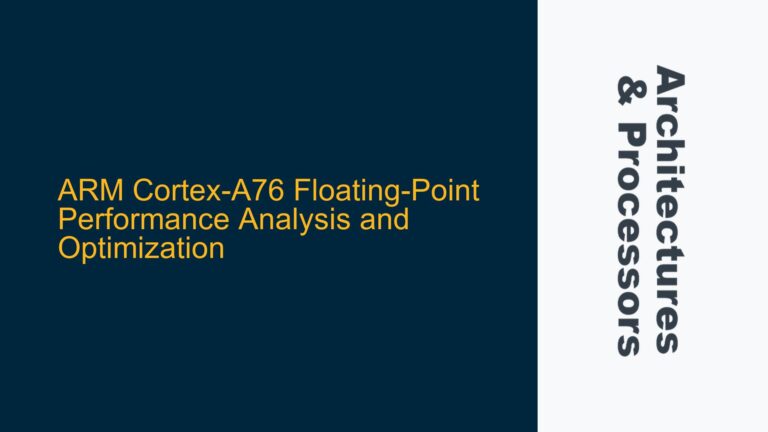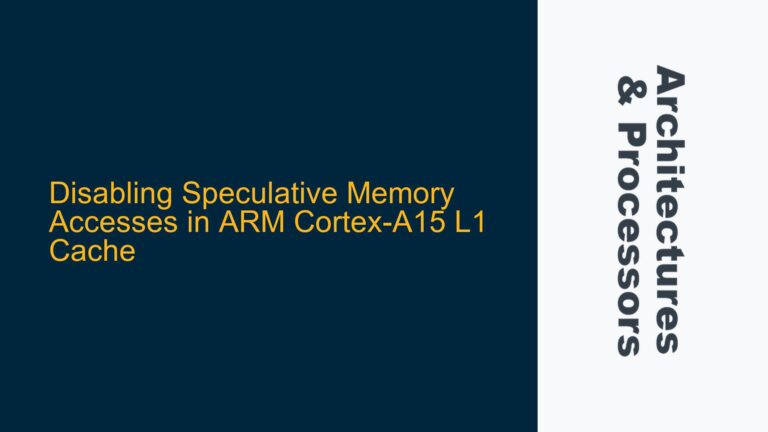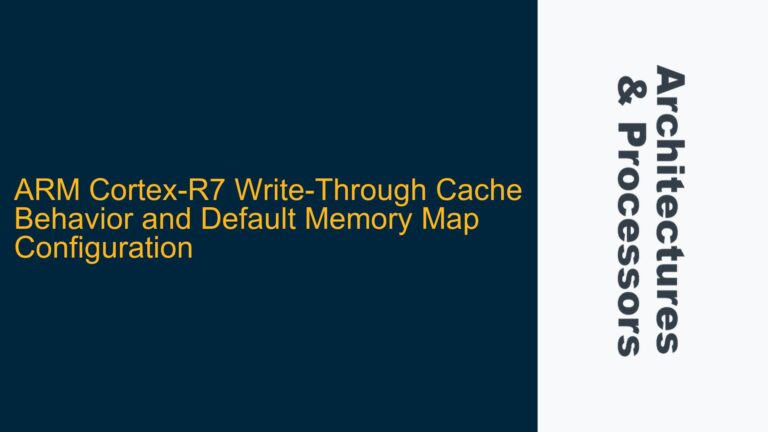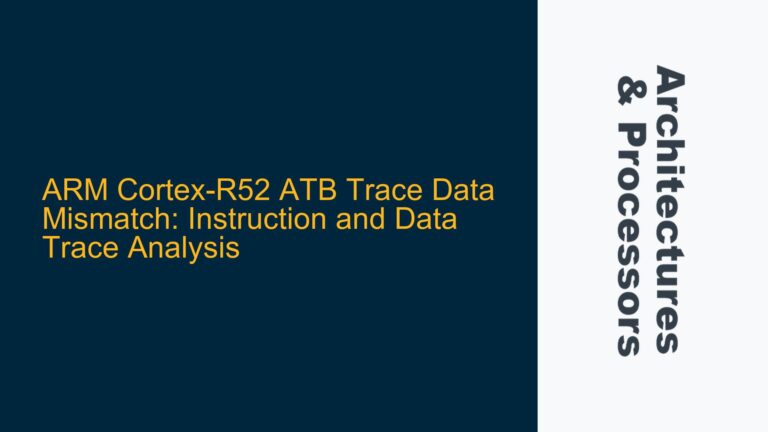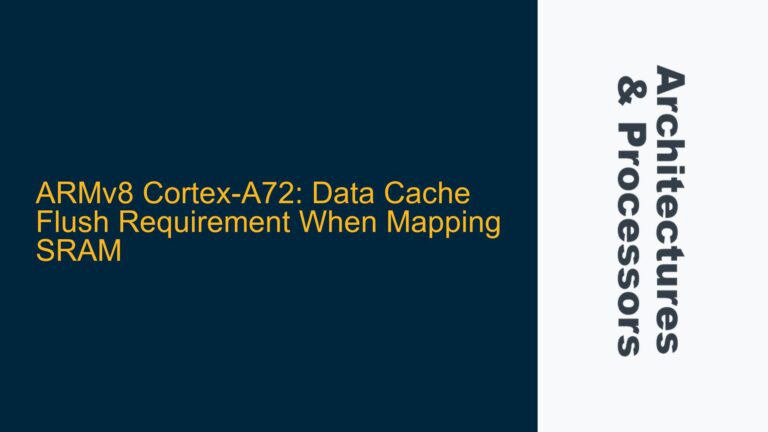ARM Cortex Pipeline Corruption Leading to Illegal Instruction Exceptions
Illegal instruction exceptions in ARM architectures, particularly those arising from Undefined Abort exceptions, are often indicative of severe underlying issues in the system. These exceptions occur when the CPU encounters an instruction that it cannot decode or execute, which may be due to corruption in the instruction stream. In a well-tested embedded system, such exceptions are rare and typically point to hardware-level anomalies rather than software bugs. The corruption can occur at various stages within the CPU pipeline, including the re-order buffer (ROB), pipeline registers (fetch, decode, execute), centralized scheduler, program counter (PC) register, Global History Buffer (GHB), and Branch Target Address Cache (BTAC).
The ARM Cortex pipeline is designed to handle instructions efficiently, but it is not immune to transient faults, especially in environments prone to radiative events or other forms of electromagnetic interference. When an illegal instruction is detected, the CPU triggers an Undefined Abort exception, which halts normal execution and transfers control to an exception handler. The handler must then determine the cause of the exception and take appropriate corrective actions. However, simply handling the exception is not sufficient; the system must also ensure that the pipeline is in a consistent state before attempting to resume normal operation.
The instruction causing the exception may have been corrupted after being fetched from memory but before being executed. This corruption can occur in the L1 or L2 caches, which are typically protected by parity or ECC (Error-Correcting Code). However, these mechanisms may not detect all types of errors, particularly multi-bit errors that escape SECDED (Single Error Correction, Double Error Detection) ECC. Furthermore, the DDR memory, which is protected by SECDED ECC, may also experience multi-bit errors that go undetected, leading to corrupted instructions being fetched into the CPU pipeline.
In addition to cache and memory errors, the pipeline itself can be a source of corruption. The re-order buffer, which holds instructions waiting to be executed, may contain corrupted data due to transient faults. Similarly, the pipeline registers, which store intermediate results and control signals as instructions move through the pipeline, can also be affected. The centralized scheduler, which manages the flow of instructions through the pipeline, may inadvertently propagate corrupted data if it is not properly protected. The program counter, which keeps track of the next instruction to be fetched, may also be corrupted, leading to incorrect instruction fetches. Finally, the Global History Buffer and Branch Target Address Cache, which are used for branch prediction, may contain corrupted data that affects the flow of execution.
To recover from an illegal instruction exception, the system must first flush the pipeline to remove any corrupted instructions. This includes flushing the re-order buffer and invalidating the Branch Target Address Cache and Global History Buffer. The program counter must then be reset to the address of the illegal instruction, allowing it to be re-fetched from memory. However, this approach assumes that the memory itself is not corrupted and that the instruction can be safely re-fetched. If the memory is corrupted, additional measures must be taken to ensure that the system can recover gracefully.
Memory Corruption and Multi-Bit Errors in SECDED ECC Protected Systems
One of the primary challenges in recovering from illegal instruction exceptions is dealing with memory corruption, particularly in systems protected by SECDED ECC. SECDED ECC is designed to detect and correct single-bit errors and detect double-bit errors in memory. However, it is not capable of correcting multi-bit errors, which can lead to undetected corruption of instructions in memory. When such corruption occurs, the CPU may fetch an illegal instruction, leading to an Undefined Abort exception.
In systems where memory corruption is a concern, it is essential to implement additional mechanisms to detect and handle multi-bit errors. One approach is to use a hash function, such as xxhash64 or CRC32, to generate a checksum for the code area in memory. The code area is typically read-only, so the checksum can be computed once and stored in a secure location. During runtime, the checksum can be recomputed and compared to the stored value to detect any changes in the code area. If a mismatch is detected, the system can take corrective actions, such as reloading the code from a known good source or triggering a system reset.
Another approach is to use a combination of hardware and software techniques to enhance memory integrity. For example, some ARM processors support hardware-based memory scrubbing, which periodically reads and corrects memory locations to prevent the accumulation of errors. Software-based techniques, such as periodic memory tests and error logging, can also be used to detect and handle memory corruption. In addition, redundant memory systems, such as dual-channel or triple-channel memory, can be used to provide additional protection against memory errors.
In systems where memory corruption is detected, it is important to record the address of the corrupted instruction to prevent the system from entering an endless loop. The exception handler should log the address and any relevant context information, such as the contents of the CPU registers and the state of the pipeline. This information can be used for debugging and analysis, and it can also be used to implement more sophisticated recovery mechanisms, such as dynamic code patching or instruction emulation.
Implementing Pipeline Flushing and Instruction Replay for Recovery
To recover from an illegal instruction exception, the system must first flush the pipeline to remove any corrupted instructions. This involves clearing the re-order buffer, which holds instructions waiting to be executed, and invalidating the Branch Target Address Cache and Global History Buffer, which are used for branch prediction. The program counter must then be reset to the address of the illegal instruction, allowing it to be re-fetched from memory.
Flushing the pipeline is a critical step in the recovery process, as it ensures that the CPU is in a consistent state before attempting to resume normal operation. The ARM architecture provides several mechanisms for flushing the pipeline, including the Data Synchronization Barrier (DSB) and Instruction Synchronization Barrier (ISB) instructions. The DSB instruction ensures that all memory accesses are completed before proceeding, while the ISB instruction ensures that the pipeline is flushed and that subsequent instructions are fetched from memory.
After flushing the pipeline, the system must re-fetch the illegal instruction from memory. This involves resetting the program counter to the address of the illegal instruction and allowing the CPU to fetch and execute the instruction again. However, this approach assumes that the memory is not corrupted and that the instruction can be safely re-fetched. If the memory is corrupted, additional measures must be taken to ensure that the system can recover gracefully.
One approach to handling memory corruption is to use a combination of hardware and software techniques to detect and correct errors. For example, some ARM processors support hardware-based error correction, such as ECC and parity protection, which can detect and correct single-bit errors and detect double-bit errors. Software-based techniques, such as checksum verification and memory scrubbing, can also be used to detect and handle memory corruption.
In addition to flushing the pipeline and re-fetching the illegal instruction, the system must also ensure that the Branch Target Address Cache and Global History Buffer are invalidated. These structures are used for branch prediction, and if they contain corrupted data, they can lead to incorrect branch predictions and further corruption of the instruction stream. Invalidating these structures ensures that the CPU will fetch the correct instructions from memory and that the pipeline will remain in a consistent state.
Finally, the system must implement a mechanism for handling multi-bit errors that escape SECDED ECC protection. This can be done using a combination of hardware and software techniques, such as redundant memory systems, checksum verification, and dynamic code patching. By implementing these techniques, the system can detect and handle memory corruption, ensuring that it can recover gracefully from illegal instruction exceptions and continue to operate reliably.
In conclusion, recovering from illegal instruction exceptions in ARM architectures requires a comprehensive approach that addresses both hardware and software issues. By flushing the pipeline, invalidating the Branch Target Address Cache and Global History Buffer, and implementing mechanisms for detecting and handling memory corruption, the system can recover gracefully from illegal instruction exceptions and continue to operate reliably. Additionally, by using techniques such as checksum verification and dynamic code patching, the system can detect and handle multi-bit errors that escape SECDED ECC protection, ensuring that it can recover from even the most severe memory corruption events.

